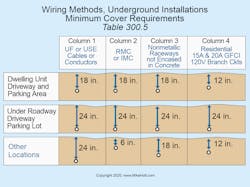Courtesy of www.MikeHolt.com
All questions and answers are based on the 2020 NEC.
Q. What are the rules related to installing raceways and cables underground?
A. You can find these requirements in Sec. 300.5. Here’s a short recap for your review.
(A) Minimum Cover Requirements. When cables or raceways are installed underground, they must have a minimum cover per Table 300.5 (see Fig. 1 below).
(B) Wet Locations. Cables and insulated conductors installed in underground enclosures or raceways must be listed as suitable for a wet location [Sec. 310.10(C)].
(C) Cables and Conductors Under Buildings. Cables and conductors installed under a building must be installed within a raceway that extends past the outside walls of the building.
(D) Protecting Underground Cables and Conductors. Direct-buried conductors and cables such as Types MC, UF, and USE installed underground must be protected from damage per (1) through (4).
(1) Emerging from Grade. Direct-buried cables and conductors that emerge from grade must be protected against physical damage. Protection is not required to extend more than 18 in. below grade, and protection above ground must extend to a height of not less than 8 ft.
(2) Conductors Entering Buildings. Underground conductors and cables that enter a building must be protected to the point of entrance.
(3) Underground Service Conductors. Underground service conductors must have their location identified by a warning ribbon placed in the trench at least 12 in. above the underground conductor installation.
(4) Raceway Damage. Where a raceway is subject to physical damage, the conductors must be installed in EMT, RMC, IMC, RTRC-XW, or Schedule 80 PVC conduit.
(E) Underground Splices and Taps. Direct-buried conductors or cables can be spliced or tapped underground without a splice box [Sec. 300.15(G)] if the splice or tap is made per Sec. 110.14(B).
(F) Backfill. Backfill material for underground wiring is not permitted to damage underground raceways, cables, or conductors.
Q. What are the requirements for securing and supporting raceways and cable assemblies?
A. Raceway and cable assemblies must be secured and supported per the requirements in Sec. 300.11.
(A) Secured in Place. Raceways, cable assemblies, and enclosures must be securely fastened in place.
(B) Wiring Systems Installed Above Suspended Ceilings. Ceiling-support wires or the ceiling grid are not permitted to support raceways or cables. Independent support wires secured at both ends can be used to support raceways or cables.
(C) Raceways Used for Support. Raceways are not permitted to support other wiring methods, except as follows (see Fig. 2 below):
(2) Class 2 and 3 Circuits. Class 2 and 3 cables can be supported by the raceway that supplies power to the equipment controlled by the Class 2 or 3 circuits.
(D) Cables Not Used as Means of Support. Cables are not permitted to support other wiring methods.
These materials are provided to us by Mike Holt Enterprises in Leesburg, Fla. To view Code training materials offered by this company, visit www.mikeholt.com/code.
About the Author

Mike Holt
Mike Holt is the owner of Mike Holt Enterprises (www.MikeHolt.com), one of the largest electrical publishers in the United States. He earned a master's degree in the Business Administration Program (MBA) from the University of Miami. He earned his reputation as a National Electrical Code (NEC) expert by working his way up through the electrical trade. Formally a construction editor for two different trade publications, Mike started his career as an apprentice electrician and eventually became a master electrician, an electrical inspector, a contractor, and an educator. Mike has taught more than 1,000 classes on 30 different electrical-related subjects — ranging from alarm installations to exam preparation and voltage drop calculations. He continues to produce seminars, videos, books, and online training for the trade as well as contribute monthly Code content to EC&M magazine.



